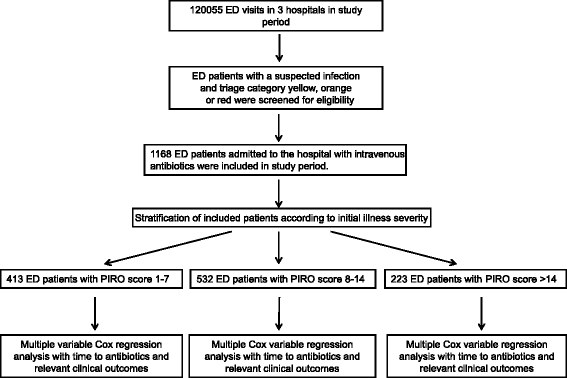The association between time to antibiotics and relevant clinical outcomes in emergency department patients with various stages of sepsis: a prospective multi-center study
- PMID: 25925412
- PMCID: PMC4440486
- DOI: 10.1186/s13054-015-0936-3
The association between time to antibiotics and relevant clinical outcomes in emergency department patients with various stages of sepsis: a prospective multi-center study
Abstract
Introduction: In early sepsis stages, optimal treatment could contribute to prevention of progression to severe sepsis. Therefore, we investigated if there was an association between time to antibiotics and relevant clinical outcomes in hospitalized emergency department (ED) patients with mild to severe sepsis stages.
Methods: This is a prospective multicenter study in three Dutch EDs. Patients were stratified into three categories of illness severity, as assessed by the predisposition, infection, response, and organ failure (PIRO) score: PIRO score 1 to 7, 8 to 14 and >14 points, reflected low, intermediate, and high illness severity, respectively. Consecutive hospitalized ED patients with a suspected infection who were treated with intravenous antibiotics were eligible to participate in the study. The primary outcome measure was the number of surviving days outside the hospital at day 28 which was used as an inverse measure of hospital length of stay (LOS). The secondary outcome measure was 28-day mortality, taking into account the time to mortality. Multivariable Cox regression analysis was used to estimate the association between time to antibiotics and the primary and secondary outcome measures corrected for confounders, including appropriateness of antibiotics and initial ED resuscitation, in three categories of illness severity.
Results: Of the 1,168 included patients, 112 died (10%), while 85% and 95% received antibiotics within three and six hours, respectively. No association between time to antibiotics and surviving days outside the hospital or mortality was found. Only in PIRO group 1 to 7 was delayed administration of antibiotics (>3 hours) associated with an increase in surviving days outside the hospital at day 28 (hazard ratio: 1.46, 95% confidence interval: 1.05 to 2.02 after correction for potential confounders).
Conclusions: In ED patients with mild to severe sepsis who received antibiotics within six hours after ED presentation, a reduction in time to antibiotics was not found to be associated with an improvement in relevant clinical outcomes.
Figures
Similar articles
-
The prognostic performance of the predisposition, infection, response and organ failure (PIRO) classification in high-risk and low-risk emergency department sepsis populations: comparison with clinical judgement and sepsis category.Emerg Med J. 2014 Apr;31(4):292-300. doi: 10.1136/emermed-2012-202165. Epub 2013 Feb 14. Emerg Med J. 2014. PMID: 23413151
-
Sepsis patients in the emergency department: stratification using the Clinical Impression Score, Predisposition, Infection, Response and Organ dysfunction score or quick Sequential Organ Failure Assessment score?Eur J Emerg Med. 2018 Oct;25(5):328-334. doi: 10.1097/MEJ.0000000000000460. Eur J Emerg Med. 2018. PMID: 28338533 Free PMC article.
-
Comparison of Predisposition, Insult/Infection, Response, and Organ dysfunction, Acute Physiology And Chronic Health Evaluation II, and Mortality in Emergency Department Sepsis in patients meeting criteria for early goal-directed therapy and the severe sepsis resuscitation bundle.J Crit Care. 2012 Aug;27(4):362-9. doi: 10.1016/j.jcrc.2011.08.013. Epub 2011 Oct 26. J Crit Care. 2012. PMID: 22033054
-
Antibiotics administered within 1 hour to adult emergency department patients screened positive for sepsis: a systematic review.Eur J Emerg Med. 2020 Aug;27(4):260-267. doi: 10.1097/MEJ.0000000000000654. Eur J Emerg Med. 2020. PMID: 31855885
-
A Critical Analysis of the Literature on Time-to-Antibiotics in Suspected Sepsis.J Infect Dis. 2020 Jul 21;222(Suppl 2):S110-S118. doi: 10.1093/infdis/jiaa146. J Infect Dis. 2020. PMID: 32691835 Review.
Cited by
-
The Timing of Early Antibiotics and Hospital Mortality in Sepsis.Am J Respir Crit Care Med. 2017 Oct 1;196(7):856-863. doi: 10.1164/rccm.201609-1848OC. Am J Respir Crit Care Med. 2017. PMID: 28345952 Free PMC article.
-
An observational study on the impact of overcrowding towards door-to-antibiotic time among sepsis patients presented to emergency department of a tertiary academic hospital.BMC Emerg Med. 2024 Apr 12;24(1):58. doi: 10.1186/s12873-024-00973-4. BMC Emerg Med. 2024. PMID: 38609924 Free PMC article.
-
Use of antibiotics in the ambulance for sepsis patients: is earlier really better?J Thorac Dis. 2018 Mar;10(3):1239-1241. doi: 10.21037/jtd.2018.02.49. J Thorac Dis. 2018. PMID: 29708139 Free PMC article. No abstract available.
-
Association between time to emergency neurosurgery and clinical outcomes for spontaneous hemorrhagic stroke: A nationwide observational study.PLoS One. 2022 Apr 28;17(4):e0267856. doi: 10.1371/journal.pone.0267856. eCollection 2022. PLoS One. 2022. PMID: 35482789 Free PMC article.
-
The association between intravenous fluid resuscitation and mortality in older emergency department patients with suspected infection.Int J Emerg Med. 2019 Jan 5;12(1):1. doi: 10.1186/s12245-018-0219-2. Int J Emerg Med. 2019. PMID: 31179911 Free PMC article.
References
Publication types
MeSH terms
Substances
LinkOut - more resources
Full Text Sources
Other Literature Sources
Medical


